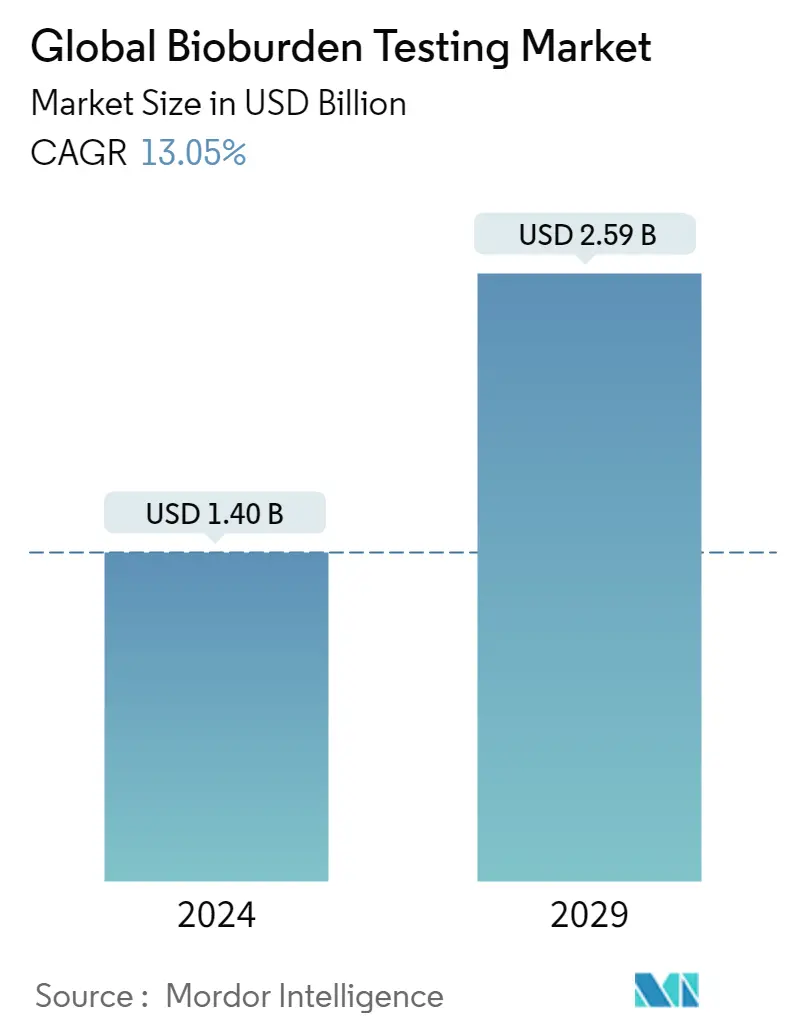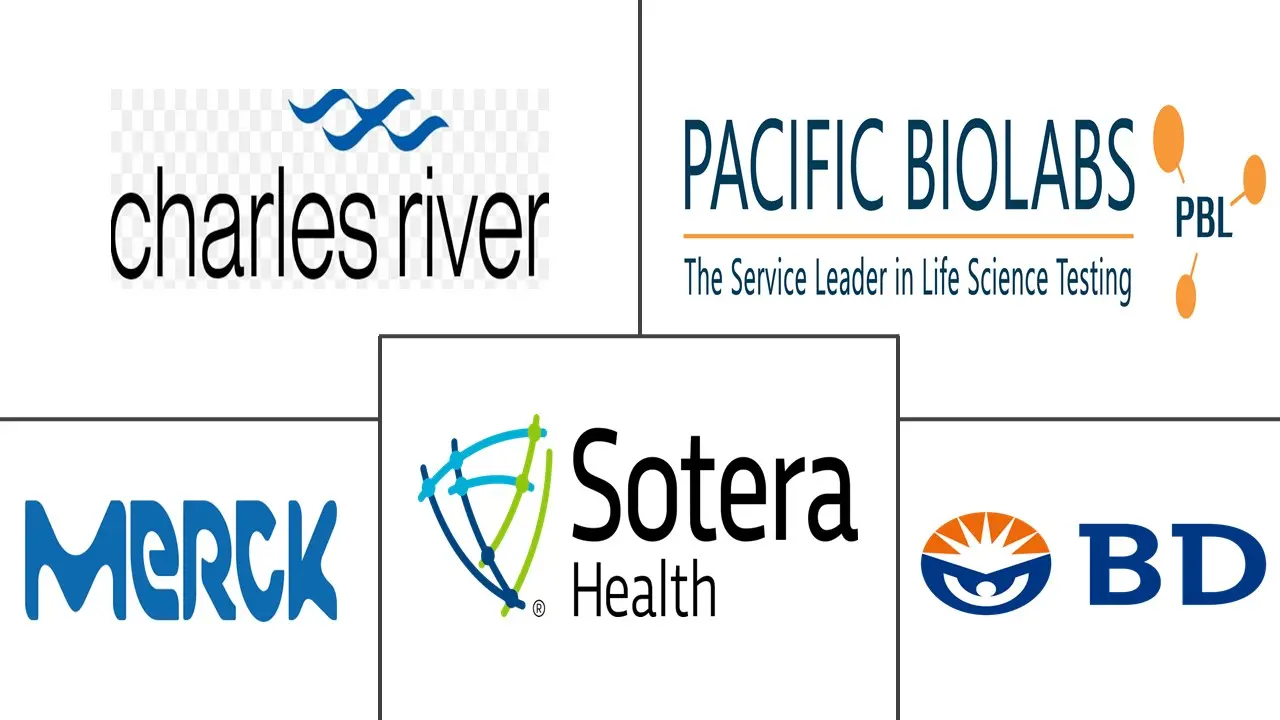Market Size of Global Bioburden Testing Industry

| Study Period | 2019 - 2029 |
| Market Size (2024) | USD 1.40 Billion |
| Market Size (2029) | USD 2.59 Billion |
| CAGR (2024 - 2029) | 13.05 % |
| Fastest Growing Market | Asia-Pacific |
| Largest Market | North America |
| Market Concentration | Low |
Major Players
*Disclaimer: Major Players sorted in no particular order |
Bioburden Testing Market Analysis
The Global Bioburden Testing Market size is estimated at USD 1.40 billion in 2024, and is expected to reach USD 2.59 billion by 2029, growing at a CAGR of 13.05% during the forecast period (2024-2029).
With COVID-19, many regulatory bodies like the United States Food and Drug Administration (FDA) have deemed it necessary to maintain adequate sterilization that can facilitate the rapid turnaround of sterilized or disinfected medical devices, raw materials, and packaging to help reduce the contamination and ensure the safety of the novel diagnostic tests and drugs developed for the treatment and management of COVID-19. As per the study published in November 2021, titled "Infection prevention and surgery in the pandemic era" this article has reviewed the measures that have been implemented and have helped infection control in surgery, such as testing, patient isolation, personal protective equipment, and ventilation. Additionally, during COVID-19 pandemic, the Eurofins Medical Device Testing network of laboratories has worked to give expert assistance in examining the safety and efficacy of COVID-19-fighting technologies. Thus, during the COVID-19 pandemic, researchers and healthcare practitioners were more focused on bioburden testing, and this tendency is predicted to continue over the projected period.
The major factors boosting the market growth are the high frequency of product recall due to microbial contamination and increasing research and development investments in life sciences. The high potential of microbial contamination and bioburden during pharmaceutical and biologics manufacturing is seen as a major motivator for governments and corporate companies to implement diverse biological safety practices due to consequences like product recall. For instance, in June 2022, Green Pharmaceuticals Inc voluntarily recalled to the consumer level lot 2373/21222 of SnoreStop NasoSpray, packed in 0.3 FL OZ (9ml) bottles. The product recall happened due to microbiological contamination with Providencia rettgeri. Additionally, in March 2022, Plastikon Healthcare, LLC voluntarily recalled three lots of Milk of Magnesia 2400 mg/30 mL Oral Suspension, one lot of Acetaminophen 650mg/ 20.3mL, and six lots of Magnesium Hydroxide 1200mg/Aluminum Hydroxide 1200mg/Simethicone 120mg per 30 mL. The products are being recalled as a result of microbial contamination and a failure to adequately examine failed microbiological testing. Thus, with the increase in the product recall due to microbial contamination the demand for microbial testing is expected to increase over the forecast period.
Furthermore, increase in the pharmaceutical research and development is another factor which is contributing to the market growth. For instance, according to the September 2021 data from Pharmaceutical Research and Manufacturers of America (PhRMA), since 2000, PhRMA member companies have invested more than USD 1.1 trillion in the search for new treatments and cures, including USD 102.3 billion in 2021 alone. Furthermore, this R&D expenditure is further expected to increase in coming years, which is likely to contribute to the market growth. Additionally, increasing research and development in the field of life sciences, coupled with huge public and private funding in the sector boost the market growth. The Indian Ministry of Science and Technology allocated a budget of INR 35 billion for the Department of Biotechnology (DBT) of India in the Union Budget for the year 2021-2022, a 25% increase from the 2020-2021 budget, primarily for biotechnology research and development as well as industrial and entrepreneurship development in the country, which will boost the studied market. Hence, all the above-mentioned factors are contributing to the market growth.
However, the high cost of microbial enumeration instruments may restrain the market growth over the forecast period.
Bioburden Testing Industry Segmentation
As per the scope of the report, bioburden testing is an integral part of validation and revalidation of sterilization processes, assessment of the efficiency of cleaning processes, routine monitoring of manufacturing processes, monitoring of raw materials, components, or packaging, and overall environmental monitoring programs. The Bioburden Testing Market is segmented by Product (Consumables and Instruments), Enumeration Method (Membrane Filtration, Plate Count Method, Most Probable Number (MPN), and Other Enumeration Methods), Application (Raw Material Testing, Medical Devices Testing, In-process Testing, Equipment Cleaning Validation, and Other Applications), and Geography (North America, Europe, Asia-Pacific, Middle East and Africa, and South America). The market report also covers the estimated market sizes and trends for 17 different countries across major regions, globally. The report offers the value (in USD million) for the above segments.
| By Product | ||||||
| ||||||
|
| By Enumeration Method | |
| Membrane Filtration | |
| Plate Count Method | |
| Most Probable Number (MPN) | |
| Other Enumeration Methods |
| By Application | |
| Raw Material Testing | |
| Medical Devices Testing | |
| In-process Testing | |
| Equipment Cleaning Validation | |
| Other Applications |
| Geography | ||||||||
| ||||||||
| ||||||||
| ||||||||
| ||||||||
|
Global Bioburden Testing Market Size Summary
The bioburden testing market is poised for significant growth, driven by the increasing need for microbial contamination control in various industries, particularly pharmaceuticals and medical devices. The COVID-19 pandemic has underscored the importance of bioburden testing, as regulatory bodies like the FDA emphasized the need for stringent sterilization processes to ensure the safety of medical devices and drugs. This heightened focus on infection control measures has led to a sustained demand for bioburden testing, a trend expected to continue in the coming years. The market is further bolstered by the rising frequency of product recalls due to microbial contamination, prompting companies to invest in robust biological safety practices. Additionally, substantial investments in life sciences research and development are fueling market expansion, as both public and private sectors allocate significant funding to advance biotechnology and pharmaceutical innovations.
North America emerges as the largest market for bioburden testing, driven by high research and development expenditures, numerous product recalls, and supportive government initiatives. The region's demand is further amplified by the ongoing need for drug discovery and the development of medical devices, which necessitate rigorous bioburden testing to ensure product safety and efficacy. Key players in the market, such as Becton, Dickinson and Company, Charles River Laboratories Inc., and Merck KGaA, are actively engaging in strategic initiatives like mergers, acquisitions, and partnerships to enhance their market presence and develop innovative testing solutions. The adoption of advanced molecular methods, such as PCR-based testing, is also contributing to market growth by offering rapid and precise detection of microbial agents. Despite the high cost of microbial enumeration instruments posing a potential challenge, the overall market outlook remains positive, with continued growth anticipated over the forecast period.
Global Bioburden Testing Market Size - Table of Contents
-
1. MARKET DYNAMICS
-
1.1 Market Overview
-
1.2 Market Drivers
-
1.2.1 High Frequency of Product Recall Due to Microbial Contamination
-
1.2.2 Increasing R&D Investments in Life Sciences
-
-
1.3 Market Restraints
-
1.3.1 High Costs of Microbial Enumeration Instruments
-
-
1.4 Porter's Five Forces Analysis
-
1.4.1 Threat of New Entrants
-
1.4.2 Bargaining Power of Buyers/Consumers
-
1.4.3 Bargaining Power of Suppliers
-
1.4.4 Threat of Substitute Products
-
1.4.5 Intensity of Competitive Rivalry
-
-
-
2. MARKET SEGMENTATION (Market Size by Value - USD Million)
-
2.1 By Product
-
2.1.1 Consumables
-
2.1.1.1 Culture Media and Reagents
-
2.1.1.2 Other Consumables
-
-
2.1.2 Instrument
-
2.1.2.1 Automated Microbial Identification Systems
-
2.1.2.2 Polymerase Chain Reaction (PCR) Systems
-
2.1.2.3 Microscopes
-
2.1.2.4 Other Instruments
-
-
-
2.2 By Enumeration Method
-
2.2.1 Membrane Filtration
-
2.2.2 Plate Count Method
-
2.2.3 Most Probable Number (MPN)
-
2.2.4 Other Enumeration Methods
-
-
2.3 By Application
-
2.3.1 Raw Material Testing
-
2.3.2 Medical Devices Testing
-
2.3.3 In-process Testing
-
2.3.4 Equipment Cleaning Validation
-
2.3.5 Other Applications
-
-
2.4 Geography
-
2.4.1 North America
-
2.4.1.1 United States
-
2.4.1.2 Canada
-
2.4.1.3 Mexico
-
-
2.4.2 Europe
-
2.4.2.1 Germany
-
2.4.2.2 United Kingdom
-
2.4.2.3 France
-
2.4.2.4 Italy
-
2.4.2.5 Spain
-
2.4.2.6 Rest of Europe
-
-
2.4.3 Asia-Pacific
-
2.4.3.1 China
-
2.4.3.2 Japan
-
2.4.3.3 India
-
2.4.3.4 Australia
-
2.4.3.5 South Korea
-
2.4.3.6 Rest of Asia-Pacific
-
-
2.4.4 Middle East and Africa
-
2.4.4.1 GCC
-
2.4.4.2 South Africa
-
2.4.4.3 Rest of Middle-East and Africa
-
-
2.4.5 South America
-
2.4.5.1 Brazil
-
2.4.5.2 Argentina
-
2.4.5.3 Rest of South America
-
-
-
Global Bioburden Testing Market Size FAQs
How big is the Global Bioburden Testing Market?
The Global Bioburden Testing Market size is expected to reach USD 1.40 billion in 2024 and grow at a CAGR of 13.05% to reach USD 2.59 billion by 2029.
What is the current Global Bioburden Testing Market size?
In 2024, the Global Bioburden Testing Market size is expected to reach USD 1.40 billion.

